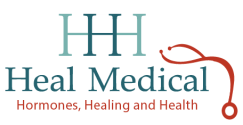I recently attended a conference on cardiovascular disease and I was struck by the overwhelming prevalence of this disease in Americans. It is the number 1 killer, responsible for more than 750,000 deaths a year; this is more than all cancers combined. And yet, what people fear most is cancer; and in my practice dealing with bio identical hormones, what they fear is breast cancer, which kills 40,000 women a year. While this is not insignificant, the average woman’s risk for CVD is 10 times that.
Just A Little Heart Attack (courtesy Go Red For Women)
When a woman goes to the doctor, she is asked if she has had her mammogram, PAP smear, colonoscopy, but very few physicians stress the risk for CVD with the exception of perhaps checking one’s total cholesterol, “good and bad” cholesterol, and saying you probably need to lose some weight. You should know that even if your cholesterol is normal, this does not mean you are without risk. Fifty percent of people who have a heart attack have “normal” cholesterol. The cholesterol story is much more complex than just the simple “good vs. bad cholesterol” that you know about. We now know that the most important risk factor is the number and size of the LDL particles. The standard cholesterol test is virtually worthless and should be replaced by a Lipid Particle Analysis that measures size, number and type of lipid particles.
Most people know that hypertension, smoking, abnormal cholesterol, diabetes, obesity, and a sedentary lifestyle put them at increased risk for CVD. Even if we modify all the major risk factors listed above, we won’t do away with heart disease. Many other lesser-known risk factors such as elevated homocysteine, elevated blood sugar, chronic infections, decreased omega 3 fats, decreased estradiol, visceral obesity, oxidative stress, and others contribute to CVD risk. We have to start addressing these lesser-known risk factors in lower the number of CVD patients in America.
Hypertension is a marker for vascular dysfunction. It is a disturbance in the function of the endothelium, which is the cell layer that lines the blood vessels. The endothelium is compromised by inflammation, oxidative stress, micronutrient deficiencies, hormone imbalance, etc., and this leads to hypertension, which is a major risk factor for CVD. Hypertension is not a “disease” but is a response to many insults to the vasculature. Hypertension is not irreversible, and frequently can be resolved when the insults and deficiencies are corrected.
I want people to become more aware of their risk for CVD. Normal weight, “normal” cholesterol, not smoking, a “normal” blood sugar, and normal blood pressure do not protect one against CVD. You can reduce your risk for CVD, but it involves more than taking medication to lower your cholesterol and blood pressure. We will look at your diet and lifestyle, their micronutrient deficiencies, lipid particles, waist circumference, glucose/insulin resistance metabolism, hormone imbalance, and endothelial dysfunction to determine your risk and plan a course to optimize your chances of remaining free of CVD.
It is important to realize that CVD is relatively silent until disease is present. For women in particular, the first event may be death from a heart attack. While CVD affects men and women equally, women tend to fair worse. They are more likely to die from an initial vascular event. They are treated with aggressive interventions less frequently. As I said earlier, most women seem unaware that the biggest risk for early death they face is from a cardiovascular event, not breast or other cancers.
Mark Houston, MD, has a new book “What Your Doctor May Not Tell You About Heart Disease”, that is very readable and gives you information on how to determine your risk and what you can do about it.
CVD is the number one cause of death in the US. Here are the statistics on CVD.
– CVD accounts for more deaths than all cancers combined
– CVD accounts for 30% of the 2.5 million deaths that occur each year
– The highest rate of death is in black males, followed by white males, black females and white females
– 2200 Americans die of CVD each day/1 death every 39 seconds
– 150,000 people are <age 65 at the time of death
– 1/3 of deaths occur before age 75
– Stroke is responsible for 1 of every 18 deaths (1 stroke every 40 seconds)
Heart disease and stroke – cardiovascular disease – are expensive for the world. In 2003, cardiovascular disease cost the European Union $169 billion.1 The most up to date data from the United States of America shows that cardiovascular disease costs nearly $310.23 billion in direct and indirect annual costs.2 By comparison, the estimated cost of all cancers is $146.19 billion and HIV infections, $22.24 billion.
US Map of Mortality (A larger version can be found here: http://www.cdc.gov/gis/mg_heartdisease_stroke.htm)
Notice the concentration of chronic disease and death in the south. This is likely a direct reflection of the high fat, high carbohydrate, low residue diet that is a staple in the south. The south also has the highest rates of obesity and diabetes.
Interactive world life expectancy map: http://www.worldlifeexpectancy.com/
CVD Risk Factors – Statistics
Hypertension – 1/3 of adults >20 have hypertension; only about ½ have their hypertension controlled
Smoking – adults >18 _20% of men and women continue to smoke
Abnormal lipids – 34,000,000 Americans have abnormal lipids levels
Diabetes – 18,300,000, 7 million undiagnosed DM, and 37% have prediabetes with abnormal fasting glucose
Obesity – 1/3 of adults are obese (Body Mass Index greater than 30); 30% of children are overweight or obese
Sedentary lifestyle – 36%



[…] Cardiovascular Disease – #1 Killer | Marsha Nunley, MD […]